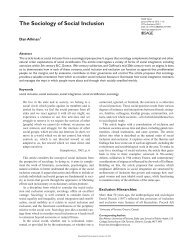Inclusive Education for Learners With Disabilities in ... - SAGE Open
Inclusive Education for Learners With Disabilities in ... - SAGE Open
Inclusive Education for Learners With Disabilities in ... - SAGE Open
Create successful ePaper yourself
Turn your PDF publications into a flip-book with our unique Google optimized e-Paper software.
Mukhopadhyay et al. 7toward <strong>in</strong>clusion of learners with disabilities <strong>in</strong> regularschools. The f<strong>in</strong>d<strong>in</strong>gs of these studies reported negative attitudesof teachers toward <strong>in</strong>clud<strong>in</strong>g such learners <strong>in</strong> generaleducation classrooms. Pr<strong>in</strong>cipals of schools were found toshow more favorable attitudes toward students with disabilitiesthan was shown by classroom teachers.The teachers and school-heads of the current study werevery concerned with the lack of support and nonavailabilityof resources <strong>in</strong> primary schools. To be specific, educators<strong>in</strong>dicated that there was a lack of appropriate <strong>in</strong>structionalmaterials needed <strong>for</strong> students with disabilities. In addition,they regretted the <strong>in</strong>sufficient time available <strong>for</strong> collaborationand consult<strong>in</strong>g with other teachers, parents, and professionalsto meet the learn<strong>in</strong>g needs of students withdisabilities. The f<strong>in</strong>d<strong>in</strong>gs of this study resonate well with thestudy carried out by Ocloo and Subbey (2008). They foundthat Ghanaian teachers were well aware of the concept of<strong>in</strong>clusive education, but <strong>in</strong>adequate <strong>in</strong>frastructure and teachers’lack of tra<strong>in</strong><strong>in</strong>g impeded the implementation of <strong>in</strong>clusiveeducation.The f<strong>in</strong>d<strong>in</strong>g of this study is consistent with the f<strong>in</strong>d<strong>in</strong>gs ofstudies conducted by Masimega (1999) and Gaotlhobogwe(2001) <strong>in</strong> Botswana. Over a period of 10 years, very little hasbeen done to provide appropriate resources <strong>for</strong> learners withdisabilities. Given the fact that there is a dearth of resourcesrequired <strong>for</strong> successful implementation of <strong>in</strong>clusive education<strong>in</strong> develop<strong>in</strong>g countries, teachers should be tra<strong>in</strong>ed to be<strong>in</strong>novative so that they can produce their own <strong>in</strong>structionalmaterials and adapt them to suit the needs of learners withdisabilities. This can be achieved through <strong>in</strong>-service tra<strong>in</strong><strong>in</strong>g,possibly <strong>in</strong> conjunction with teacher tra<strong>in</strong><strong>in</strong>g <strong>in</strong>stitutions.These f<strong>in</strong>d<strong>in</strong>gs have been corroborated by other studies <strong>in</strong>develop<strong>in</strong>g countries, <strong>in</strong>clud<strong>in</strong>g Alur (2002) and S<strong>in</strong>gal(2005, 2006) <strong>in</strong> India, and Johnstone and Chapman (2009) <strong>in</strong>Lesotho. These researchers expressed concern about thedearth of resources as one of the challenges <strong>for</strong> the successfulimplementation of <strong>in</strong>clusive education. This importantaspect needs to be built <strong>in</strong>to the guidel<strong>in</strong>es <strong>for</strong> <strong>in</strong>clusiveeducation.It is our op<strong>in</strong>ion that the current situation is appall<strong>in</strong>gbecause most urban primary schools do not have sufficientclassrooms to accommodate learners. Some schools haveresource rooms, but because of the shortage of classrooms,they are used as regular classrooms. In one school, learnerswith hear<strong>in</strong>g impairments were <strong>for</strong>ced to attend classes outdoorsnext to a noisy, heavily trafficked area. The majority ofthe classrooms were <strong>in</strong>accessible to learners with physicaldisabilities; <strong>for</strong> example, although some schools had ramps,some of the ramps were too steep <strong>for</strong> students with physicaldisabilities to move up them <strong>in</strong>dependently. Necessary facilitiessuch as toilets were <strong>in</strong>accessible. Structural barriers tendto limit <strong>in</strong>dependent access to classroom and school activities,and impact negatively on participation and competence<strong>in</strong> the curricular and cocurricular activities.Collaborative activities among general and special educatorsare essential <strong>in</strong> develop<strong>in</strong>g a work environment thatfosters <strong>in</strong>clusive practice. Data from this study suggest thatregular education teachers did not collaborate as much asspecial educators <strong>in</strong> develop<strong>in</strong>g <strong>in</strong>structional plans, <strong>in</strong>team-teach<strong>in</strong>g <strong>in</strong> the regular classroom, and <strong>in</strong> provid<strong>in</strong>gassistance to each other regard<strong>in</strong>g students with disabilities.This f<strong>in</strong>d<strong>in</strong>g was corroborated by studies carried outby researchers such as deBettencourt (1999). These f<strong>in</strong>d<strong>in</strong>gsreflect that major obstacles to <strong>in</strong>clusive education atthe primary school level often result from pragmatic factorssuch as limited time, large class size, heavy workload,exist<strong>in</strong>g regulations, and <strong>in</strong>sufficient <strong>in</strong>stitutional support.Thus, it is important <strong>for</strong> school systems to encourage teachersto work cooperatively, and also to provide them withopportunities to plan and share <strong>in</strong><strong>for</strong>mation if students withdisabilities are to be successfully educated <strong>in</strong> <strong>in</strong>clusiveclassrooms (Turnbull, Turnbull, Shank, & Lead, 1999).It also emerged from the data that school systems andadm<strong>in</strong>istrators do not provide the additional help needed byprimary school special educators and general educatorswork<strong>in</strong>g <strong>in</strong> <strong>in</strong>clusive classrooms. Accord<strong>in</strong>g to researchers(Brownell & Pajares, 1999), successful <strong>in</strong>clusive ef<strong>for</strong>ts areassociated with adm<strong>in</strong>istrative support, adequate materials,and personnel resources. If <strong>in</strong>clusive education is to beimplemented successfully, school systems need to <strong>in</strong>volveparents, teachers, students, and key community members <strong>in</strong>districtwide plann<strong>in</strong>g.School-heads seemed to lack adm<strong>in</strong>istrative and decisionmak<strong>in</strong>gpowers such as arrang<strong>in</strong>g teach<strong>in</strong>g schedules, reduc<strong>in</strong>gclass sizes, provid<strong>in</strong>g <strong>in</strong>-service tra<strong>in</strong><strong>in</strong>g, or appropriateuse of specially tra<strong>in</strong>ed teachers. There were no funds allottedto schools <strong>for</strong> <strong>in</strong>clusive education <strong>in</strong>-service tra<strong>in</strong><strong>in</strong>g. It is theresponsibility of the Special <strong>Education</strong> Division of theM<strong>in</strong>istry of <strong>Education</strong> and Skills Development to organizesuch tra<strong>in</strong><strong>in</strong>g programs. Teachers who were qualified as specialeducators were frustrated because of <strong>in</strong>appropriate deployment.Teachers’ views <strong>in</strong>dicate that clear policies are neededto guide the implementation of <strong>in</strong>clusive education. Policydocuments should outl<strong>in</strong>e relevant resources, support services,and service delivery <strong>for</strong> learners with diverse learn<strong>in</strong>g needs <strong>in</strong>an <strong>in</strong>clusive setup.The results of the current study <strong>in</strong>dicate that implementationof <strong>in</strong>clusive education is a complex process. Manyfactors operate at the macro, meso, and micro levels of educationalsystems (i.e., the level of the school system, theclassroom, and the <strong>in</strong>dividual learner) and are closelynested around learners with disabilities. There<strong>for</strong>e, active<strong>in</strong>volvement of all stakeholders and positive <strong>in</strong>teractionbetween multiple systems are important <strong>for</strong> successfulimplementation of <strong>in</strong>clusive education.Conclusions and RecommendationsThe study established that students with disabilities posechallenges <strong>for</strong> teachers <strong>in</strong> the regular classroom. The presentstudy <strong>in</strong>dicated that there were some possible effects ofprogram quality on <strong>in</strong>dividuals’ beliefs about <strong>in</strong>clusiveDownloaded from by guest on January 12, 2015















